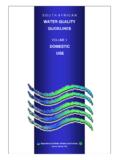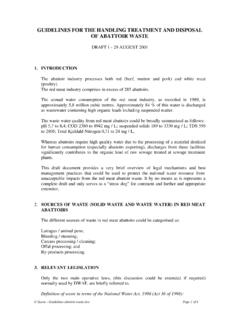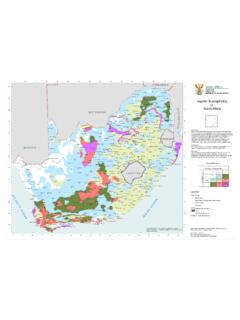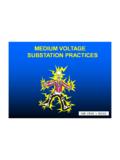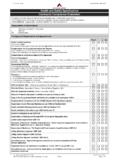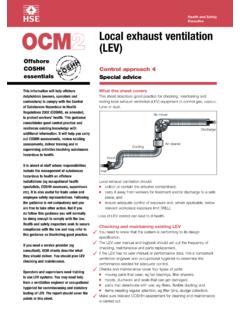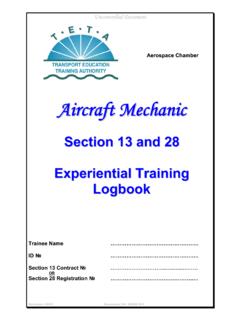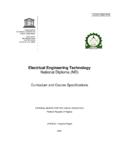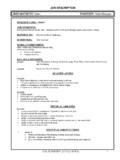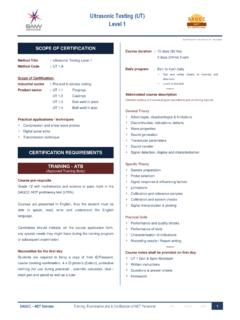Transcription of GRADUATE TRAINEE LOGBOOK - dwa.gov.za
1 Page 1 of 60 LEARNING ACADEMY GRADUATE TRAINEE LOGBOOK QUALIFICATION INITIALS AND SURNAME YEAR OF COMMENCEMENT PERSAL NUMBER Name PN Year BEng. MECHANICAL ENGINEERING Page 2 of 60 Table of Contends SECTION 1 .. 4 DEFINITIONS, GENERAL INFORMATION AND ROLES AND RESPONSIBILITIES .. 4 1. DEFINITIONS .. 5 2. GENERAL INFORMATION .. 5 3. ECSA POLICY STATEMENT R2/1C - ENGINEER .. 6 Significance of registration as a Professional Engineer .. 6 Criteria for Registration .. 6 Scope and Level of Engineering Work for Candidate Engineers .. 7 Duration of Practical Training .. 7 Documentation for the Recording of Training .. 7 4. ROLES AND RESPONSIBILITIES .. 8 Project 8 Stream Leader .. 8 Mentor .. 9 The GRADUATE TRAINEE .
2 9 SECTION 2 .. 10 PERSONAL INFORMATION; SUMMARY OF WORKPLACE EXPOSURE, EVALUATION OF TRAINING & AND COMMENTS .. 10 PERSONAL INFORMATION .. 11 SECTION 3 .. 42 DETAILED LOG OF EXPOSURE .. 42 SECTION 4 .. 47 PROBATION REPORTS .. 47 SECTION 5 .. 53 DETAILED STRUCTURED TRAINING PROGRAM .. 53 1. BASIC TRAINING (1 year) .. 54 1. Introduction 3 months .. 54 Computer literacy .. 54 Induction course .. 54 Internal Mechanical / Electrical Engineering administration procedures 54 Structure of the National Water Resource Infrastructure branch and the Directorate: Mechanical / Electrical .. 54 Report writing .. 54 Water supply schemes .. 54 Field trip/s .. 54 The GRADUATE TRAINEE accompanies senior engineers to site/s for practical experience on water supply schemes.
3 54 Workshop training 3 weeks .. 54 Quality Control .. 54 Occupational Health and Safety and First Aid .. 54 Corrosion protection .. 54 2. MECHANICAL SPECIFIC (3 months) .. 55 Gates .. 55 Field trip .. 55 Valves and pipes .. 55 Field trip .. 55 Pumps .. 55 Field trip/s .. 55 Outlet 55 Field trip/s .. 55 Maintenance of equipment .. 55 Field trip/s .. 55 Hydraulics .. 55 3. DRAWING 3 MONTHS .. 56 Page 3 of 60 CAD Training .. 56 4. DESIGN PHASE 12 MONTHS .. 57 Design of equipment .. 57 Cost estimates / Bugeting .. 57 Writing of specifications .. 57 Compilation of tenders .. 57 Planning / programs .. 57 Management of Contracts .. 57 5. MAINTENANCE PHASE (6 months) .. 58 Compile maintenance contract .. 58 Manage maintenance contract.
4 58 Inspection of equipment .. 58 Dam Safety inspections .. 58 System 58 Pump 58 Vibration tests .. 58 Emergency Repair and preparation .. 58 Plant Refurbishment and Repair .. 58 Diving Work .. 58 6. TRAINING REPORT .. 59 SECTION 6 .. 60 SUPPORTING DOCUMENTS .. 60 Page 4 of 60 SECTION 1 DEFINITIONS, GENERAL INFORMATION AND ROLES AND RESPONSIBILITIES Page 5 of 60 1. DEFINITIONS TERM DEFINITION Learning academy A departmental institution initiated and supported by government to address development of skills in the various disciplines Professional bodies A structured body controlling the competence of a candidate member in the respective field of qualification in accordance with the relevant legislation and applicable requirements Program manager The head of the Learning Academy ensuring compliance of training and workplace exposure of GRADUATE Trainees with professional body requirements Project Coordinator A person facilitating.
5 Co-ordinating and supporting all Learning Academy activities Stream leader A person facilitating and co-ordinating the management of mentors Mentor A person overseeing the training and workplace exposure of the GRADUATE TRAINEE Supervisor A person undertaking daily supervision and training in accordance with a structured training program GRADUATE TRAINEE A candidate undertaking relevant training and workplace exposure with the intention of registering as a professional with the relevant professional body when applicable Structured training program A time bound program designed by professionals complying with professional body requirements and standards 2. GENERAL INFORMATION The GRADUATE TRAINEE is contractually appointed for a maximum duration of 5 years to undertake a structured training program in order to obtain professional status.
6 A stream leader will be allocated by the Project Coordinator in the specific field of qualification. A mentor, in addition to the supervisor, will be allocated to the GRADUATE TRAINEE by the stream leader for specific time frames on a rotational basis. The mentor will ensure implementation of the relevant structured training program. The mentor may in turn appoint a supervisor. Proper lines of communication must be adhered to GRADUATE TRAINEE Supervisor/ Mentor Stream Leader Project Coordinator Program Manager Page 6 of 60 3. ECSA POLICY STATEMENT R2/1C - ENGINEER (a) Professional Engineers are concerned primarily with the progress of technology through innovation, creativity and change. Their work involves the application of a significant range of fundamental principles, enabling them to develop and apply new technologies, promote advanced designs and design methods, introduce new and more efficient production techniques, marketing and construction concepts, and pioneer new engineering services and management methods.
7 They may be involved with the management and direction of high risk and resource intensive projects. Professional Engineers undertake and lead varied work that is essentially intellectual in nature, requiring discretion and judgement. Such work has its base in proficiencies and competencies derived from and extended by experience and research. It is concerned with cost effective, timely, reliable, safe, aesthetically pleasing and environmentally sustainable outcomes. (b) Candidate Engineers are people who have passed an accredited programme(s) and/or examination recognised by Council is eligible for registration in the candidate engineer category in terms of the Engineering Profession Act, 2000 (Act No.)
8 46 of 2000). Significance of registration as a Professional Engineer The significance of registration as a Professional Engineer is that: (a) It is a commitment to subscribe to the standards set by ECSA and to work within the ECSA Code of Conduct. (b) It is proof of competency in terms of the standards of a Professional Engineer, measured by peers. These features contribute to the protection of the public with respect to the work of a Professional Engineer and lend confidence in appointing such a person to carry out engineering work. Criteria for Registration (a) In the case of a person applying for registration as a candidate [engineer] has satisfied the relevant educational outcomes determined by the council for this purpose, by: (i) having passed accredited or recognised examinations at any educational institution offering educational programmes in engineering; and (ii) having passed any other examination that may be determined by the council; or (iii) presenting evidence of prior learning in engineering.
9 (b) In the case of a person applying for registration as a professional [engineer]: (i) has demonstrated his or her competence as measured against standards determined by the council for the relevant category of registration; and Page 7 of 60 (ii) has passed any additional examinations that may be determined by the council. Scope and Level of Engineering Work for Candidate Engineers Acceptable practical training must provide satisfactory experience to candidate engineers in the application of engineering principles and methods and must include the practical training elements as stated in to , at the level of responsibility stated in (3 .1) Problem Investigation The work must be aimed at investigating engineering problems and for which engineering judgement is required.
10 The following practical engineering functions are contained in such work to a greater or lesser degree: (a) problem identification and formulation; (b) finding and selecting relevant information; (c) evaluating, investigating, testing and research; (d) analysis of all factors that influence the solution like relevant engineering and scientific principles; ( ) Problem Solution The work must be aimed at the full development of the suggested solution to the problem through a process of synthesis, with the application of all information acquired during the problem investigation, also using design, development and communication. This includes but is not limited to the drawing up of plans, detailed designs, reports, specifications, adjudication of tenders taking into account all practical, economic, social, environmental, quality assurance, safety and statutory factors.


